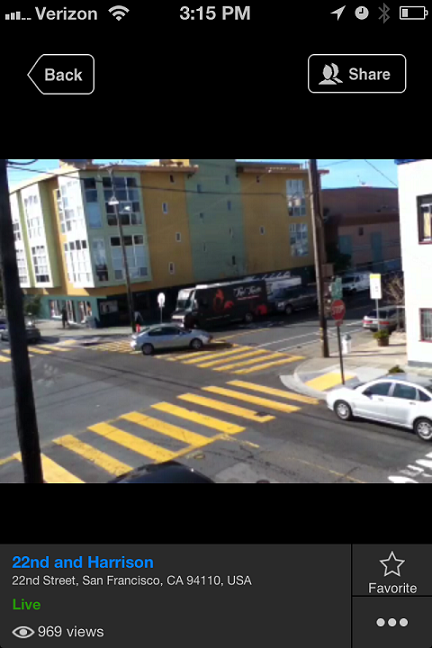Let the People Live-Stream?
A startup called Koozoo rolled out an iPhone app today that invites anyone to join the company’s quest to build a network of livestreaming cameras–initially just in San Francisco and Austin, Texas–with the idea that, eventually, you’ll be able to check out camera views all over your city, too (assuming enough people start using it).

I’ve been testing it out for several days, and while it’s a neat idea that seems to work decently well, I’m baffled by it. Unless you’ve got an amazing view, why would you want to stream it for all the world to see? And unless you know there are lots of cool things to watch, why would you spend time checking out various live cams? Also, while some people do have an old smartphone lying around that they can use for continuous, fixed video recording, most of us don’t, which means you either need to let your current smartphone sit idle to catch a good view, or just stream in little spurts.
Here’s where I think it could be useful, and potentially profitable: lines and crowds, as Koozoo helpfully points out on its website. We all hate waiting in lines and wading through crowds. Live-streaming the lines at hot restaurants, bars, and other places (a la NYC’s Shake Shack’s Shack Cam) would be great. And I bet businesses would pay Koozoo to do this for them, since it could help consumers figure out the best time to stop by and make it easier for the businesses to maintain a steady flow of customers.
Some early Koozoo adopters are already hip to this idea–this afternoon I spotted cameras that let you check out the line at the San Francisco DMV, a taqueria, or view the crowd at an Austin bar. That’s a lot more useful than checking out the view at the corner of Haight and Ashbury or a local playground.
Somewhat odd disclosure: My boyfriend just built and installed a bike rack at Koozoo’s San Francisco office.
Keep Reading
Most Popular
Large language models can do jaw-dropping things. But nobody knows exactly why.
And that's a problem. Figuring it out is one of the biggest scientific puzzles of our time and a crucial step towards controlling more powerful future models.
The problem with plug-in hybrids? Their drivers.
Plug-in hybrids are often sold as a transition to EVs, but new data from Europe shows we’re still underestimating the emissions they produce.
Google DeepMind’s new generative model makes Super Mario–like games from scratch
Genie learns how to control games by watching hours and hours of video. It could help train next-gen robots too.
How scientists traced a mysterious covid case back to six toilets
When wastewater surveillance turns into a hunt for a single infected individual, the ethics get tricky.
Stay connected
Get the latest updates from
MIT Technology Review
Discover special offers, top stories, upcoming events, and more.